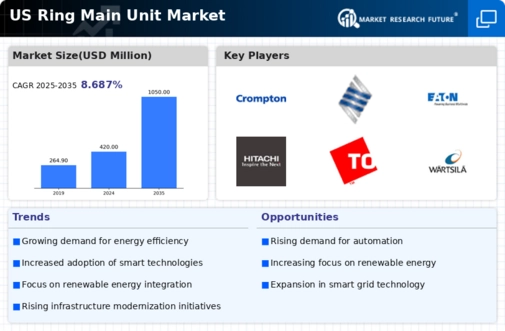Investment in Renewable Energy Sources
The transition towards renewable energy sources is significantly impacting the ring main-unit market. As the US aims to increase its renewable energy capacity, the need for efficient power distribution systems becomes critical. Ring main units play a vital role in integrating renewable energy sources, such as solar and wind, into the existing grid infrastructure. The ring main-unit market is expected to benefit from this shift, as utilities and energy providers invest in modernizing their distribution networks. In 2025, investments in renewable energy are projected to reach $100 billion, further driving the demand for advanced distribution solutions. This trend indicates a growing recognition of the importance of sustainable energy practices, which in turn enhances the market for ring main units.
Urbanization and Infrastructure Development
Rapid urbanization in the US is a key driver for the ring main-unit market. As cities expand and populations increase, the demand for efficient electrical distribution systems rises correspondingly. The ring main-unit market is poised to benefit from ongoing infrastructure development projects aimed at accommodating growing urban populations. In 2025, urban areas are expected to account for over 80% of electricity consumption, necessitating the implementation of advanced distribution technologies. This urban-centric demand creates opportunities for ring main units, which offer flexibility and reliability in power distribution. Additionally, government initiatives to upgrade aging infrastructure further support the growth of the market, as municipalities seek to enhance their electrical systems to meet the needs of modern urban environments.
Regulatory Framework and Supportive Policies
The regulatory environment in the US plays a crucial role in shaping the ring main-unit market. Supportive policies aimed at enhancing electrical infrastructure and promoting energy efficiency are driving market growth. The ring main-unit market benefits from regulations that encourage the adoption of modern distribution technologies. In 2025, it is expected that new regulations will mandate the use of advanced distribution systems in new construction projects, further propelling the demand for ring main units. This regulatory support is likely to create a favorable landscape for manufacturers and suppliers, as they align their offerings with compliance requirements. Additionally, incentives for energy-efficient solutions may further stimulate market growth, as stakeholders seek to meet regulatory standards while optimizing their electrical systems.
Technological Integration and Smart Solutions
The integration of advanced technologies into electrical distribution systems is reshaping the ring main-unit market. The adoption of smart solutions, such as IoT and automation, enhances the functionality and efficiency of ring main units. The ring main-unit market is experiencing a shift towards digitalization, with utilities increasingly investing in smart grid technologies. This trend is expected to drive market growth, as smart ring main units enable real-time monitoring, predictive maintenance, and improved fault detection. By 2025, the market for smart electrical distribution solutions is anticipated to grow by 15%, reflecting the increasing demand for innovative technologies. This integration not only improves operational efficiency but also contributes to enhanced reliability and safety in power distribution.
Growing Demand for Reliable Power Distribution
The increasing need for reliable power distribution systems in various sectors, including commercial and industrial, drives the ring main-unit market. As organizations seek to enhance their operational efficiency, the demand for robust electrical infrastructure becomes paramount. The ring main-unit market is witnessing a surge in adoption due to its ability to provide uninterrupted power supply and minimize downtime. In 2025, the market is projected to grow at a CAGR of approximately 6.5%, reflecting the urgency for dependable power solutions. This trend is particularly evident in urban areas where the density of electrical loads is high, necessitating advanced distribution systems. Furthermore, the integration of smart grid technologies is likely to bolster the demand for ring main units, as they facilitate better monitoring and management of electrical networks.























Leave a Comment